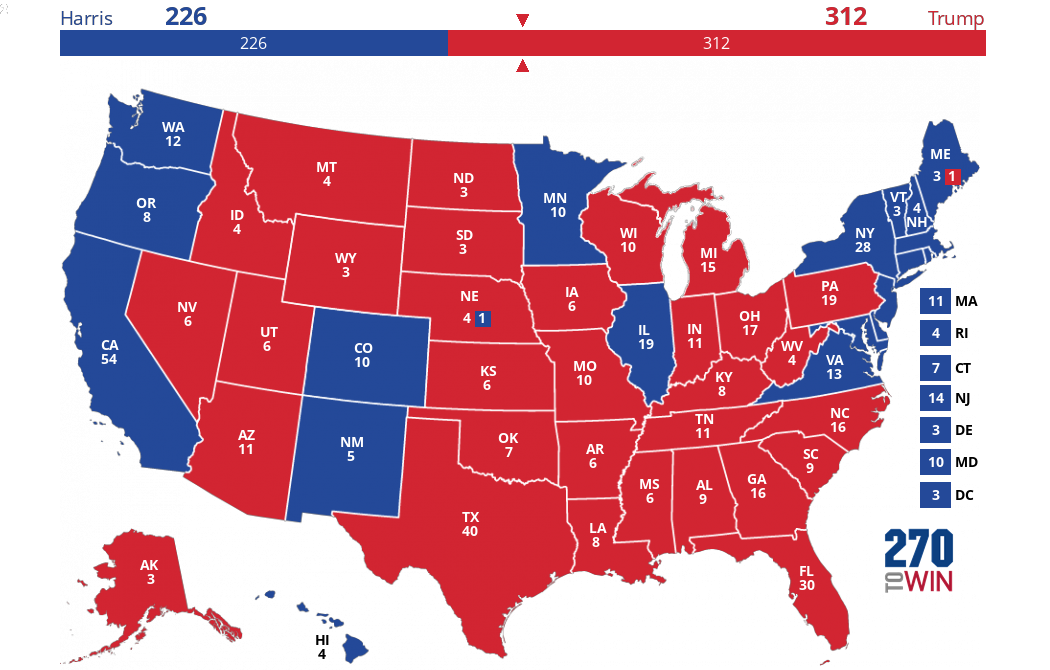Indiana
Indiana joined the Union in December 1816. It has been primarily Republican throughout its history, and today is the “reddest” state in the Midwest. Since 1940, it has only voted Democratic in 1964, when Lyndon Johnson won a landslide over Barry Goldwater and again in 2008, when Barack Obama edged John McCain in the third closest race of that election (behind Missouri and North Carolina). Republicans have won by double-digits in the last four elections, with Donald Trump receiving 59% support to Kamala Harris's 39% in 2024.
ELECTORAL VOTES
11Recent Presidential Elections
| 2024 |
|
|||
| 2020 |
|
|||
| 2016 |
|
|||
| 2012 |
|
|||
| 2008 |
|
|||
| 2004 |
|
|||
| 2000 |
|
Presidential Voting History
State voted with the overall winning candidate
Electoral College Votes
Colored bars represent electoral votes by party. Tap or hover to see names.
U.S. Senate Voting History
| Class† | 1988 | 1990 | 1992 | 1994 | 1996 | 1998 | 2000 | 2002 | 2004 | 2006 | 2008 | 2010 | 2012 | 2014 | 2016 | 2018 | 2020 | 2022 | 2024 |
|---|---|---|---|---|---|---|---|---|---|---|---|---|---|---|---|---|---|---|---|
| 1 |
R
|
R
|
R
|
R
|
D
|
R
|
R
|
||||||||||||
| 2 | |||||||||||||||||||
| 3 |
R
|
D
|
D
|
R
|
R
|
R
|
Data: MIT Election Data and Science Lab / Harvard Dataverse through 2018; 270toWin research. These are general election results for the years listed. Special elections, if any, are excluded.
† There are three classes of Senators; one is up for election every second year. Each state has one Senator in two of the three classes.
U.S. House Voting History
| District | 1988 | 1990 | 1992 | 1994 | 1996 | 1998 | 2000 | 2002 | 2004 | 2006 | 2008 | 2010 | 2012 | 2014 | 2016 | 2018 | 2020 | 2022 | 2024 |
|---|---|---|---|---|---|---|---|---|---|---|---|---|---|---|---|---|---|---|---|
| 1 |
D
|
D
|
D
|
D
|
D
|
D
|
D
|
D
|
D
|
D
|
D
|
D
|
D
|
D
|
D
|
D
|
D
|
D
|
D
|
| 2 |
D
|
D
|
D
|
R
|
R
|
R
|
R
|
R
|
R
|
D
|
D
|
D
|
R
|
R
|
R
|
R
|
R
|
R
|
R
|
| 3 |
R
|
D
|
D
|
D
|
D
|
D
|
D
|
R
|
R
|
R
|
R
|
R
|
R
|
R
|
R
|
R
|
R
|
R
|
R
|
| 4 |
R
|
D
|
D
|
R
|
R
|
R
|
R
|
R
|
R
|
R
|
R
|
R
|
R
|
R
|
R
|
R
|
R
|
R
|
R
|
| 5 |
D
|
D
|
R
|
R
|
R
|
R
|
R
|
R
|
R
|
R
|
R
|
R
|
R
|
R
|
R
|
R
|
R
|
R
|
R
|
| 6 |
R
|
R
|
R
|
R
|
R
|
R
|
R
|
R
|
R
|
R
|
R
|
R
|
R
|
R
|
R
|
R
|
R
|
R
|
R
|
| 7 |
R
|
R
|
R
|
R
|
R
|
R
|
R
|
D
|
D
|
D
|
D
|
D
|
D
|
D
|
D
|
D
|
D
|
D
|
D
|
| 8 |
D
|
D
|
D
|
R
|
R
|
R
|
R
|
R
|
R
|
D
|
D
|
R
|
R
|
R
|
R
|
R
|
R
|
R
|
R
|
| 9 |
D
|
D
|
D
|
D
|
D
|
D
|
D
|
D
|
R
|
D
|
D
|
R
|
R
|
R
|
R
|
R
|
R
|
R
|
R
|
| 10 |
D
|
D
|
D
|
D
|
D
|
D
|
D
|
Data: The Princeton Gerrymandering Project through 2018; 270toWin research. These are general election results for the years listed. Special elections, if any, are excluded.
Vertical lines before 1992, 2002, 2012, and 2022 show Census-related redistricting breakpoints. Geographic borders associated with each district number are likely to have changed.
Governor Voting History
Data: Wikipedia through 2018; 270toWin research. These are general election results for the years listed. Special elections, if any, are excluded.

